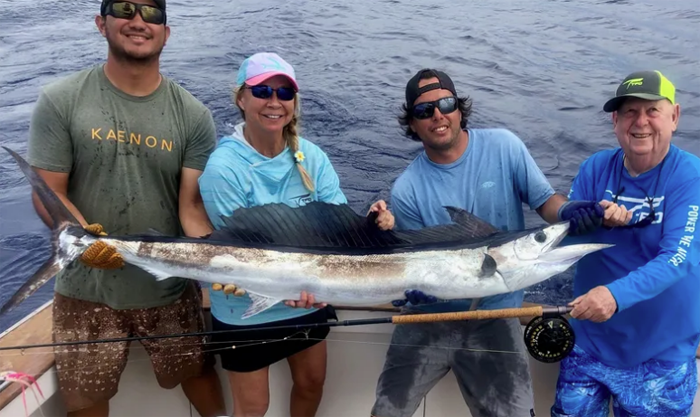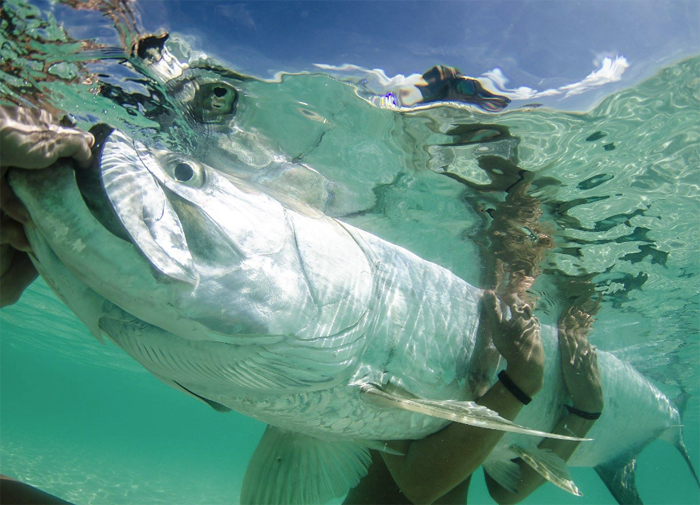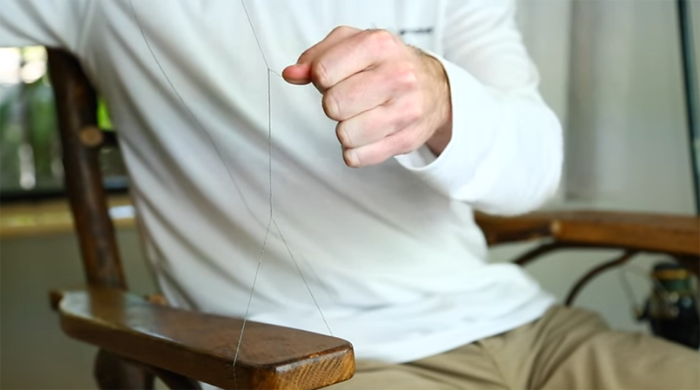
A cabin in the woods Muskoka, Canada. Photo by Patrick Tomasso [impatrickt]. The fly tyers inside this cabin will not come out until ice is off Lake Muskoka – May. A commons image.
Oh, the weather outside is frightful, But the fire is so delightful
By Skip Clement – Buzz Bryson / Saltwater Sportsman / 2001
And it was all of those things, but in the foothills of the Appalachians, it rarely snows, and so it was not. But still, it was hunkering down weather, drizzling off and on, and I was in one day into a lovely sore throat, fever, and chills, and my hair hurt. So, Angie decided to avoid me and told me to stay put until better, and she would come and get me. I decided on hot tea with honey and a teaspoon of apple cider vinegar.
I settled in, plugged in my ears, and started listening to a podcast
A pretty famous podcast host had a pretty unfamous guide from Canada as a guest and fly fishing expert. The host was extremely knowledgeable about trout fishing, and the guest knew smallmouth, walleye, pike, and those big Canadian brook trout. They were both conversant about Atlantic salmon, which is where the chit-chat went, then, while talking about salmon, they decided to wax counterfactually about backing – they were both clueless. To be fair though, many folks are, especially if not native speakers of saltwater fly fishing and the importance of backing in that ballyard.
Here’s a couple of thoughts on backing
First, the knots – one connects it to the reel spool, and although there are a few, the Duncan Loop, with about three circumference turns before tying the knot is almost failsafe. The second-knot ties the backing to the fly line, via a triple surgeon or Bimini, to the running line of the fly line with a “big loop.” Here come the arguments on knots.
Choosing the backing
The primary choices are Dacron or gel spun or GSP.
In freshwater, backing rarely serves as an essential component in the fly fisher’s outfit. For saltwater anglers, however, backing provides a vital link that keeps the angler connected to any fish powerful enough to carry 100 feet of fly line and leader off your reel.
Despite its importance, the backing is not generally given much thought. Most anglers simply decide between a standard measure of either 20- or 30-pound-test backing and have no further worries. But, as anglers challenge longer-running, deeper-diving blue-water species or choose lighter tackle and tippets for flats targets, they need every advantage to be successful. For these conditions, the right backing can go a long way toward staying connected long enough for a successful catch and release or the table when appropriate.
Types and Features
The standard backing for many years has been polyester, such as DuPont’s Dacron. This material is a proven performer, combining excellent chemical stability and durability with a moderate amount of stretch – generally between 10- to 15-percent to balance fish-fighting needs with shock absorption. In contrast, some nylon monofilaments may stretch as much as 20-percent or more.
Polyethylene-based fibers are the new player in the backing field. As with the polyester materials, there are considerable variations in the weave, the various coatings, and in the fineness of the individual fibers, but for argument’s sake, I just call it GSP, for gel-spun polyethylene, one of the most common variations. These variations make it hard to generalize about stretch, but GSP stretches far less than Dacron, only about 4- to 6- percent.
As fly anglers have considered this new “superbraid” material, the intensity of discussion has approached that of barbed versus barbless hooks or whether to reel right – or left-handed for a retrieve. As with those debates, the proportion of fact and firsthand experience to hearsay varies considerably. I’ll try to stick to the facts.
GSP is dominant for a given diameter. Therein lies both its primary benefit and the source of most of the controversy. Anglers who switched from 30-pound-test Dacron to 30- or 35-pound-test GSP found that their reels would hold twice as much or more of this superthin material. Many also quickly discovered that, unless wound on the reel very tightly, the GSP’s small diameter would dig into underlying coils when putting under pressure, which could create a jam and pop the tippet. They also found that knots traditionally used in Dacron slipped and failed in GSP and that it sliced fingers easily. Many claimed that it quickly grooved rod guides.
Let’s compare the diameter differences between Dacron and GSP in relative terms. Generally, 45- to 50-pound GSP is about the same diameter as or even smaller than 20-pound Dacron. Thus a given reel will hold about 50 percent more 45- to 50-pound GSP than it will 30-pound
Dacron
Small-diameter backing will indeed dig into loosely wound coils of underlying backing. It happens in Dacron, too, although perhaps to a lesser extent since Dacron is less slick. Backing should be wound on tightly, regardless of type. Use a glove, keep the backing under tension, and crisscross the backing frequently to prevent digging in. If using a machine to wind on the backing, try not to use extreme pressure or to wind on an excessive amount of backing. You’ll never be able to duplicate those conditions in the field, and there’s no quicker or more embarrassing way to lose a fish than having the reel jam because you have too much line on it and the fit too tight on the reel.
Knots do slip in GSP. Just as with other materials, it’s a matter of choosing the right knot. And we’ve already agreed GSP does slice fingers. It’s not as if Dacron doesn’t, but the slickness of GSP doesn’t create the friction that Dacron does when scorching across your finger. Instead, GSP can instantly cut your finger to the bone. You shouldn’t be grabbing fast-moving backing anyway, and a single lesson learned will generally be sufficient to avoid future incidents.
Guide wear happens – but not much. It is caused by the dirt and friction of the line passing over the guides. The tiptop is the guide receiving most wear, as it has the most pressure on it as the line passes in and out at a usually sharp angle. With the hardened guides used today, wear is not the problem it once was, except perhaps for those lucky enough to fish a lot. Does GSP cause increased guide wear? Although I’ve caught dozens, and hundreds of false albacore over the past several years while using GSP backing, and have seen no noticeable wear of rod guides, even looking through an 8X magnifier.
One potential advantage of GSP, in my admittedly informal tests, is that it has proven itself quite a bit more abrasion-resistant than Dacron-type backing. Repeated trials of scraping 30-pound-test Dacron and the much smaller-diameter 50-pound GSP across the edge of my concrete driveway have consistently shown that the Dacron wears through and fails before the GSP.
Most of the potential disadvantages of GSP can be worked around. The cost can’t. GSP, no matter what its form, is far more expensive than Dacron.

Bill fishing on the fly – doubtful you’ll ever see a blood knot, but a must for trout fishers. Photo taken by Capt. Keven Nakamaru aboard his boat Northern Lights on February 6, 2019. World record shortbill spearfish caught by Wanda Hair Taylor. Mates to the left and right of Taylor are Dave and Kyle – far right is Jake Jordan. Jake Jordan image.
Choosing
There are two main criteria for choosing backing, regardless of material type: breaking strength and capacity.
First, decide what minimum breaking strength is needed. As we’ve discussed, conventional backing is generally available in either 20- or 30-pound breaking strength for saltwater applications. A rule of thumb is to use backing that’s at least 50 percent stronger than your leader tippet. With that premise, you’d use leaders no stronger than about 12-pound-test with 20-pound backing. Such tippets are commonly utilized for outfits up to 8- and 9-weight. Most anglers routinely move up from 20- to 30-pound backing on their 9- or 10-weight and heavier outfits, where tippets of 15- to 20-pound tests might be used. That dividing line is consistent with another rule of thumb, which is to switch to 30-pound backing with double-digit-weight rods.
Second, determine the backing capacity you need for a particular type of fishing, and make sure that your reel will hold that amount plus the desired fly line. Those of us who cannot afford to purchase a separate reel for every species of fish we may target is forced to adapt a couple of reels to a wide variety of applications. As we change lines to meet different needs, we may find ourselves with less backing than we’d like for a situation. At that point, the angler is faced with choosing from several options. He can purchase a larger reel. He can cut off some of the running line to add capacity for backing. He can switch to a line taking less space, such as an intermediate line, or even a floating head with a thin running line. He can use less backing. Or, he can use a backing with lower breaking strength and a smaller diameter.
But anglers going after big fish with 16- or 20-pound tippets hesitate to use 20-pound conventional backing, with good reason. Thirty-pound, or even more substantial, is the minimum acceptable without risking losing the entire fly line on a break-off. Similarly, those pursuing traditional flats and inshore species with lighter tippets know that 20-pound backing is much more susceptible to abrasion by coral or barnacles than is 30-pound backing.
For anglers caught in either of those catch-22 situations, GSP backing may be the answer. As discussed above, a reel will hold approximately 50 percent more GSP in 45- to 50-pound tests compared to conventional 30-pound backing. Thus, a tarpon-sized reel with a nominal capacity of 300 yards of 30-pound Dacron will hold 450 to 500 yards or more of 50-pound GSP, making it suitable for offshore use. Similarly, a bonefish-sized reel, with a nominal capacity of 200 yards of 20-pound Dacron, will typically hold that much or more of 45- to 50-pound GSP. This allows you to spool on that same 200 yards of GSP backing and perhaps even a 10-weight line, allowing that reel to double as your permit or albacore reel.
Besides, sticking with the larger-diameter GSP in the 45- to 50-pound tests will avoid the digging-in issue, even with 16- and 20-pound tippets. Thus, for maximum flexibility, I don’t go with smaller diameter GSP, even on bonefish reels. Standardizing on one size also allows you to buy the backing in bulk spools, achieving considerable cost savings and negating to some extent the cost differential between GSP and Dacron.
Once you decide on the type and ideal amount of backing you need, you should think about color. Bright colors are preferable so that you, your guide, or other nearby boats can see where your fish is headed. Also, you’ll want a color that contrasts with your fly line, so that the backing-to-fly line junction can be seen easily. I generally prefer a hot pink or chartreuse color, both of which are easily seen under a variety of fishing conditions. (Note that GSP is not very colorfast, and manufacturers are still fighting to find a way to retain color. If you try it and it begins to fade to white, just realize it’s not losing its strength, only it’s color.)
Estimating Capacity
Reel makers typically provide only general information on how much backing a particular model reel will hold (e.g. “WF-8-F + 200 yards of 20-pound backing” or “WF-12-F + 300 yards of 30-pound backing”). Occasionally, information for a couple of lines will be given, but seldom can you find information on how much backing can be used on a particular reel in combination with a 30-foot high-density shooting head and 100 feet of monofilament running line, for example.
There is a way to make a ballpark estimate on backing and line capacity for a given reel, and it’s not overly complicated. It’s a much better way than spooling on your line first, then the backing, and then reversing everything.
First, if you’ll be using a reel with several lines, start with the bulkiest, which is almost always a full-length weight-forward floating line. If we set up the reel so that the largest weight-forward floating line we’ll likely use on that reel fits nicely, then any of the lighter weight and more dense lines will provide, although with a bit of excess space.
Starting with the reel manufacturer’s specs and your bulk spool of backing, wind on the recommended amount. How does one measure yardage from a bulk spool? Lacking a counter, I measure 100-foot and 100-yard distances between trees in my yard, and measure off the lengths of backing before spooling it on the reel. After spooling on that amount, but before cutting the backing from the bulk spool, loosely tie on the end of the fly line and spool both it and the extra 100 feet or so of backing onto the reel. If the combo underfills or overfills the reel (try and leave about 1/8 inch of excess space on the spool), adjust accordingly and then cut the backing. Peel the fly line off, tie in the appropriate knots, and you’re ready to go.

Underwater Facebook/BTT photo was taken by Capt. Jordan Carter – one of many anglers and guides who helped BTT collect scale samples for the tarpon genetics program. No Clinch Knot here. Join BTT.
Backing Knots
Typically, you’ll only have two knots associated with backing: the backing-to-reel knot, and the backing-to-fly-line knot.
For attaching the backing to the reel, the arbor knot is frequently recommended. It’s not my favorite. Instead, I prefer the simple uni-knot (Duncan’s knot). Wrap the line twice around the arbor before tying the knot, so any slipping tendency is minimized. Or, for maximum strength, tie a Bimini loop in the backing first, and then secure that doubled line to the arbor with a uni-knot. This connection is simple, and hopefully, one you’ll never see.
The backing-to-fly-line connection should be secure, and if you’re one of those anglers who routinely change fly lines on a particular reel, it should also facilitate those quick changes. If the ability to change lines quickly is not an issue for you, the venerable nail knot, a favorite of many freshwater anglers, works well for most lines and with lighter tippet strengths. It is not favored for use with a monofilament-core line, as it can fail by stripping the coating off the core in those situations. For this same reason, the nail knot is not favored when using heavy tippets. For either of those conditions, the Albright is a better choice, but it too doesn’t allow for changing lines quickly. The best connection, in my opinion, for both strength and ease of changing lines, is a loop-to-loop connection using Bimini twist loops. Make the loop in the backing large enough to pass the reel (or coiled fly line) through, and lines can be easily interchanged.
For slippery GSP backing, you’ll want to take some extra precautions with knots. The arbor uni-knot should have extra turns (say, eight to 10, instead of five), as should the Bimini (say, 30, 50, or as many as 70 twists, instead of 20). Note that the slipperiness of GSP, while contributing to knot slippage, also facilitates the tying of many-twist knots. For maximum security when using connecting loops in GSP backing to connect to the fly line loop, use noted Aussie angler Rod Harrison’s “Bionic Bind.” This is a simple variation of the loop-to-loop connection, where the fly line is figure-eight six to eight times over and under the Bimini loop in the GSP backing. Pull the connection down evenly, and the connection will never slip over.
Once you’ve got everything put together, don’t forget some occasional maintenance. Inspect and retie knots periodically, certainly before any big trips. Remove the fly line at the end of a trip, especially if you know you won’t be on the water again for a long time. Clean the reel with soapy water, and make sure to douse the backing. Let it dry before putting a fly line back on.
The backing is one of those items we want to forget. If we make the right choices initially, we can forget it and simply enjoy the fishing
https://guiderecommended.com/fly-fishing-backing/
https://gearjunkie.com/fly-fishing-line-backing-explained
https://blog.vailvalleyanglers.com/choosing-the-right-fly-line-backing/
https://www.saltwatersportsman.com/techniques/rigs-and-tips/backing-beyond-basics/
https://www.tridentflyfishing.com/blog/fly-line-backing-shootout-and-buyers-guide/


